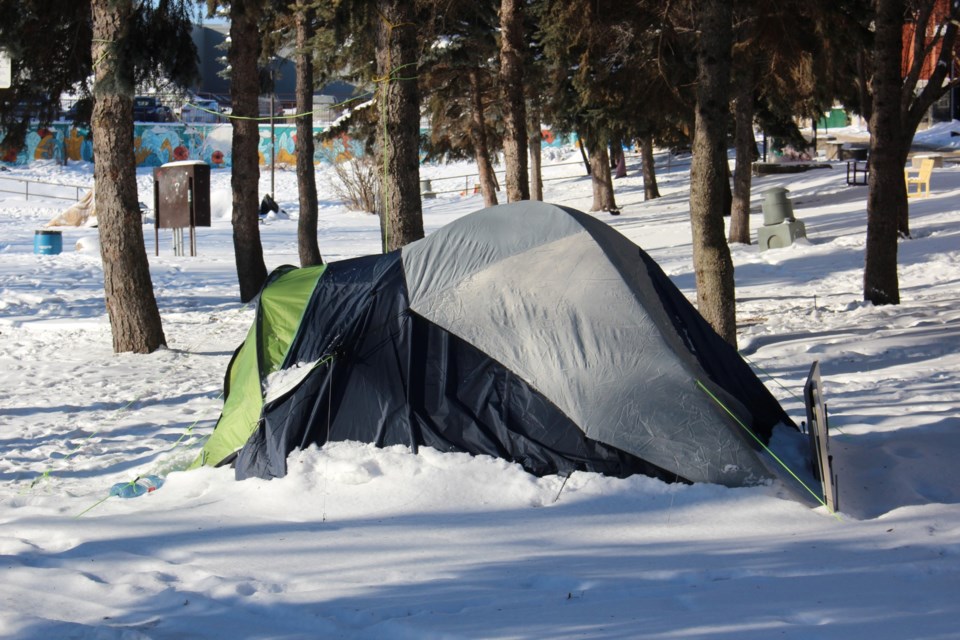EDITOR’S NOTE: This article originally appeared on The Trillium, a Village Media website devoted exclusively to covering provincial politics at Queen’s Park.
After tallying more than 80,000 people who experienced homelessness in Ontario last year, the group representing the province’s municipalities is once again raising alarms about the crisis.
On Thursday, the Association of Municipalities of Ontario released what it called “the most ambitious study of homelessness conducted across Ontario” and its president, Robin Jones, warned that “this is the floor, not the ceiling, of the issue.”
AMO said in its “Municipalities Under Pressure” report that 81,515 Ontarians experienced “known homelessness” in 2024. Its counts were based on data from the province’s 47 service managers, who help deal with homelessness.
“Known homelessness” refers to people who the social services system is aware of through their use of shelters, inclusion on service managers’ by-name lists or point-in-time counts, and more. AMO’s report notes its data “represents an almost-certain undercounting of homelessness in Ontario.”
The tally it gathered didn’t account for people who may have been homeless but didn’t interact with formal services, people staying in institutional settings like hospitals or women’s shelters, or couch surfers, as a few examples.
The total known number of people who experienced homelessness last year in Ontario was 12 per cent greater than the year before, 25 per cent higher than in 2022, and 51 per cent more than in 2016.
AMO also found that 41,512 people who experienced homelessness last year, over half the known total, were chronically homeless — meaning they were without somewhere to live for prolonged or repeated periods. Chronic homelessness has also become more common in Ontario as well, more than doubling since 2021, which AMO’s report said should be seen as “a warning sign.”
Of those known to have experienced chronic homelessness last year, one-quarter were younger than 25 years old, AMO found.
Although most of the province’s homeless population is concentrated in cities in southern Ontario, remote communities have experienced the steepest escalation of the crisis in recent years.
Compared to 2016, there were 150 per cent more homeless people in rural communities and more than 200 per cent more homeless people in northern Ontario in 2024, AMO’s report said.
In northern communities, Indigenous people represented 45 per cent of those who AMO found experienced homelessness last year. Compared to other racial groups, Indigenous people are disproportionately represented among the homeless, and, according to a representative of a company that worked with AMO on its report, more likely to be undercounted in the study.
The increase in the number of immigrants, including especially refugees, who’ve experienced homelessness has also outpaced the broader population. There were 10,552 refugees and asylum seekers recorded as homeless at some point in 2024, a sixfold increase from four years earlier, according to AMO’s findings.
The group’s study also touched on the causes of Ontario’s homelessness crisis, with its report pointing to housing shortages and emergency shelter capacity crunches as factors. It also noted that while governments’ funding aimed at addressing homelessness has increased significantly — from $1.9 billion annually to about $4.1 billion a year — since a decade ago, more will be needed to tackle the issue.
Municipal Affairs and Housing Minister Paul Calandra’s spokesperson mentioned the province’s “largest investment … in Ontario’s history” in a response to The Trillium about the report, saying that it’s already “taken decisive action to supportive municipalities in dealing with homeless encampments across the province.”
“Mayors have asked us for help in managing this complex issue and that is why over the next 3 years, we’re investing a record $3 billion in affordable housing, anti-homelessness, and emergency shelter supports,” Emma Testani, a spokesperson for Calandra, wrote in an email. “Just last month, we announced an additional targeted investment of $75 million to help connect those living in encampments with needed housing.”
Testani also directed blame toward Prime Minister Justin Trudeau’s government, saying the province wants it to “step up, pay their fair share (and) take responsibility (for) their policies that have escalated the number of individuals facing homelessness.”
Premier Doug Ford’s government is looking to take a tougher stance against homeless encampments. Just before the provincial parliament took its winter break from sitting in early December, Calandra tabled Bill 242, the Safer Municipalities Act, to make it easier for municipalities to clear homeless encampments. The Ontario legislature isn’t set to resume sitting until early March, meaning it will likely be months before the Ford government can pass the bill.
“Encampments are a public safety concern and not a solution to homelessness,” Testani wrote in her email. “We believe that people experiencing homelessness should have access to proper support and stable housing.”
In its report, AMO said “a fixed $2 billion investment” could help build enough housing and support spaces to “quickly stabilize and transition” 8,400 people out of encampments.
In another forecast in its report, AMO laid out a “10-year scenario… to achieve functional zero chronic homelessness,” which it concluded would require governments to spend $11 billion over 10 years on the issue.
AMO said in its report that $11 billion could be spent over a decade to create 75,050 new housing and support spaces, address systemic causes of homelessness, ease pressures on shelters and hospitals, and more.
“Ontario’s homelessness crisis is significant, but it is not unresolvable,” the group’s report said. “Chronic homelessness is a clear signal of an overburdened and misaligned system, but that can be addressed with bold and coordinated action.”
